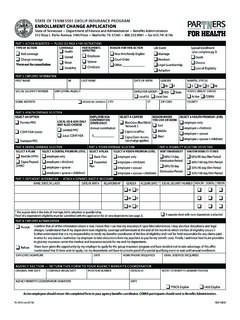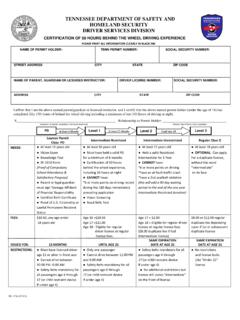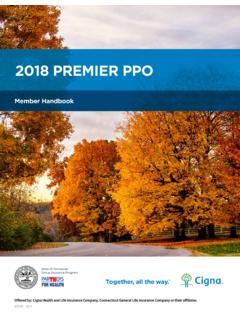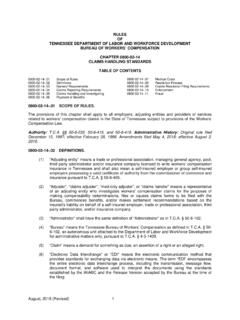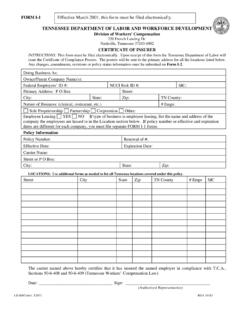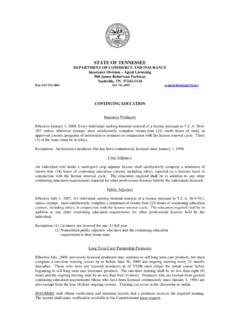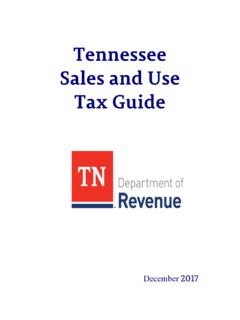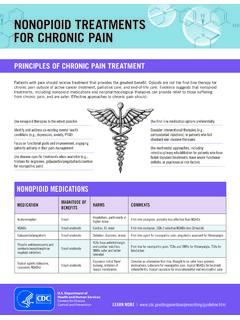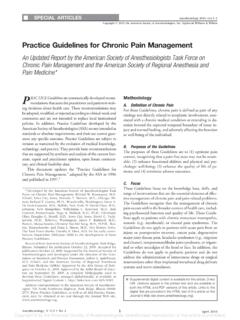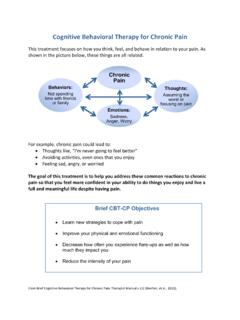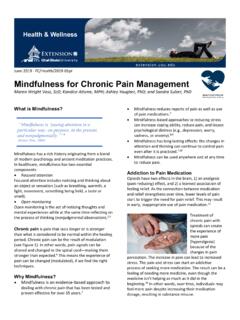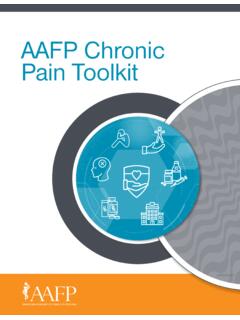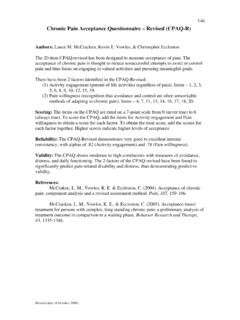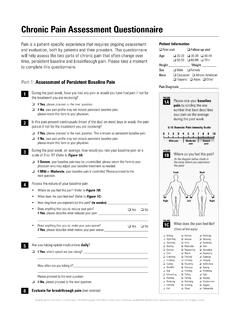Transcription of Tennessee Chronic Pain Guidelines - TN.gov
1 Tennessee Chronic pain Guidelines Clinical Practice Guidelines for Outpatient Management of Chronic Non-Malignant pain 3-TR Edition These Guidelines are not applicable to end-of-life care, emergency room care or acute pain management. The printed copy of the Chronic pain Guidelines may be updated before the next edition is printed. All updates will be posted on the electronic version. Link: Last revised: January 2020 Tennessee CLINICAL PRACTICE Guidelines FOR OUTPATIENT MANAGEMENT OF Chronic NON-MALIGNANT pain The purpose of these Guidelines is to define appropriate treatment of Chronic pain , a common and often serious condition. We want to foster timely and appropriate treatment for pain , which improves both the ability to function and quality of life. These Guidelines are intended to be used to support clinicians in their treatment of patients with Chronic pain with particular reference to the prescribing of opioid medications.
2 We want to avoid addiction and adverse outcomes. Optimal treatment of Chronic pain , defined as pain lasting longer than 90 days, is an interdisciplinary process that includes many interventions which do not always involve opioid pain medications. The method used to formulate these Guidelines included a review of national expert panel recommendations and state practice Guidelines , multiple listening sessions with clinicians in Tennessee , oversight by a multidisciplinary steering committee and recommendations from an advisory committee with strong representation by clinicians with specialty training in pain medicine. Draft clinical Guidelines were also circulated to a broader group of professional associations within Tennessee , including but not limited to mental health and substance abuse and workers compensation programs. The importance of management of Chronic pain is apparent by the following facts: In 2018, Tennessee continues to rank in Top 10 per capita prescription rate for opioids in the US.
3 Unintentional overdose deaths increased to 1,818 (from 1,776 in 2017), in spite of declining MMEs. This exceeds deaths due to motor vehicle accidents, homicide or suicide in 2018. The number of babies born dependent on drugs who suffered from Neonatal Abstinence Syndrome (NAS) declined by approximately 17%, for the first time in almost 10 years. In 2019, the decline continues. In the midst of this Substance Use Disorder epidemic, Chronic pain is likewise a significant public health problem. At least 116 million US adults more than the number affected by heart disease, diabetes and cancer combined suffer from common Chronic pain conditions. The long term goals of appropriate pain management are to improve symptoms, function and overall quality of life while minimizing adverse effects, addiction, overdose deaths and NAS. These Guidelines can help providers reduce problems associated with prescription opiates while maintaining access to compassionate care and appropriate medications for patients living with Chronic pain .
4 These Guidelines are organized into three sections and appendices contain additional tools and guidance. The Guidelines apply to all healthcare providers. These Guidelines would not apply to patients in a hospice program or in a palliative care setting with a life expectancy of six months or less. These Guidelines do not apply to patients admitted to a hospital. These Guidelines are not meant to dictate medical decision making. They are Guidelines of generally accepted medical practice rather than absolutes. Providers still have flexibility to deal with exceptional cases. Occasional deviation from these Guidelines for appropriate medical reasons is to be expected and documented. Table of Contents SECTION I: PRIOR TO INITIATING OPIOID THERAPY FOR Chronic NON-MALIGNANT pain .. 1 SECTION II: INITIATING OPIOID THERAPY FOR Chronic NON-MALIGNANT pain .. 3 SECTION III: ONGOING OPIOID THERAPY FOR Chronic NON-MALIGNANT pain .
5 5 APPENDICIES .. 7 CORE COMPETENCIES .. 7 TN TOGETHER .. 11 pain MEDICINE MENTAL HEALTH ASSESSMENT TOOLS .. 14 MEDICATION ASSISTED TREATMENT PROGRAM .. 15 WOMEN S ISSUES: WOMEN OF CHILD BEARING AGE .. 16 PREGNANT WOMEN .. 17 RISK ASSESSMENT TOOLS .. 18 CSMD: CONTROLLED SUBSTANCE MONITORING DATABASE .. 20 SAMPLE INFORMED CONSENT: Controlled Substance Agreement .. 24 SAMPLE PATIENT AGREEMENT: Controlled Substance Treatment .. 27 URINE DRUG TESTING .. 29 TAPERING PROTOCOL .. 34 MORPHINE EQUIVALENT DOSE .. 35 CO-PRESCRIBING NALOXONE .. 36 SAFETY NET .. 39 PRESCRIPTION DRUG DISPOSAL .. 41 USE OF OPIOIDS IN WORKERS COMPENSATION MEDICAL CLAIMS .. 42 MEDICAL TREATMENT Guidelines FOR pain MANAGEMENT FOR WORKERS' COMPENSATION SELECTED LINKS .. 43 Chronic pain GUIDELINE ALGORITHM WOMEN S HEALTH .. 45 Chronic pain GUIDELINE ALGORITHM OPIOID THERAPY .. 45 NON-OPIOID ACUTE pain .. 49 PERIOPERATIVE pain Tennessee EMERGENCY DEPARTMENT OPIOID PRESCRIBING PEDIATRICS pain .
6 52 DENTISTRY MINIMUM OPIOID TERMS/DEFINITIONS .. 59 LINKS .. 61 REFERENCES .. 63 SECTION I: Prior to Initiating Opioid Therapy for Chronic Non-Malignant pain SEC SECTION I: PRIOR TO INITIATING OPIOID THERAPY FOR Chronic NON-MALIGNANT pain Chronic pain Guidelines 1 Version 3TR 2020 A. Key Principles Prior to Initiating Opioid Therapy 1. A patient having been prescribed opioids by a previous provider is not, in and of itself, a reason to continue opioids. 2. Reasonable non-opioid treatments should be tried before opioids are initiated. Opioids should be initiated only after other reasonable, appropriate and available treatments for the pain condition have been considered. 3. All newly pregnant women should have a urine drug test administered by the appropriate women s health provider. 4. The provider should discuss a birth control plan to prevent unintended pregnancy with every woman of child-bearing age who has reproductive capacity when opioids are initiated.
7 5. The patient's medical history, physical examination, laboratory tests, imaging results, electro-physiologic testing, and other elements supporting the plan of care, should be documented in the medical record prior to initiating opioid therapy. 6. Chronic pain shall not be treated by the use of controlled substances through telemedicine. B. Initial Evaluation: Steps Prior to Initiating Trial of Opioid Therapy 1. A specific evaluation and history of the patient s pain condition should be obtained. The examination should include the nature and intensity of the pain , past and current treatments for pain , any co-occurring disorders and the effect of the pain on the patient s life functioning, including but not limited to work, relationships, recreation and sleep. 2. The presence of important co-morbid medical conditions should be assessed and considered when deciding whether to initiate opioids.
8 This includes age of the patient and medical conditions such as Chronic obstructive pulmonary disease, sleep apnea, diabetes or congestive heart failure. 3. An initial, condition-appropriate physical examination of the patient should be conducted. A systems review shall be conducted as well. 4. The possible presence of co-occurring mental health disorders should be considered when deciding whether to initiate a trial of opioids. Screening should occur for disorders such as depression, anxiety and current or past Substance Use Disorder and, if present, these should be addressed in the creation of a treatment plan (See Mental Health Appendix). 5. A review of prior records directly related to the patient s Chronic pain condition is encouraged before opioids are prescribed. 6. Women of child-bearing age who have reproductive capacity should be asked about the possibility of pregnancy at each visit.
9 For women who wish to avoid unintended pregnancy, use of long-acting reversible contraceptives should be discussed, or referral to appropriate high-risk obstetrician made (See Women of Child Bearing Age Appendix and Pregnant Women Appendix). SECTION I: PRIOR TO INITIATING OPIOID THERAPY FOR Chronic NON-MALIGNANT pain Chronic pain Guidelines 2 Version 3TR 2020 C. Establishing a Diagnosis There shall be the establishment of a current diagnosis that justifies a need for opioid medications. D. Assessment of Risk for Abuse 1. The prescriber shall assess the patient s risk for misuse, abuse, diversion and addiction using a validated risk assessment tool prior to initiating opioid therapy. (See Risk Assessment Tools Appendix) 2. The prescriber should obtain a Urine Drug Test (UDT) (or a comparable test on oral fluids) prior to initiating opioid therapy. (See Urine Drug Testing Appendix) 3.
10 Based on the combined information of the validated risk assessment results, the Controlled Substances Monitoring Database (CSMD) results and the UDT results and past records, an initial assessment should be made about a patient s risk of misuse, abuse or diversion of medications. The prescribing of opioids, if medically indicated, shall take this risk assessment information into account in the prescribing of opioids and the patient s treatment plan. (See CSMD Appendix) E. Goals for Treatment 1. The primary goal of treatment should be clinically significant improvement in function. 2. A treatment plan should be developed at the onset of treatment and is expected to include other treatments or modalities beyond opioids, both non-pharmacological and pharmacological. The provider should make reasonable attempts to implement this treatment plan, allowing for barriers such as finances, accessibility and resource distribution.
